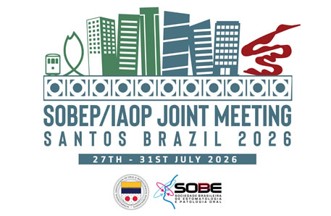Morphological Evaluation of Bone Microdamage in Medication-Related Osteonecrosis of the Jaw Using Fluorescence Microscopy
DOI:
https://doi.org/10.5327/2525-5711.361Keywords:
Osteonecrosis, Oral medicine, Bone and BonesAbstract
Objective: The aim was to assess and classify bone microdamage (microcracks, microfractures, and diffuse damage) in MRONJ using fluorescence microscopy, a method that improves artefact discrimination compared to scanning electron microscopy. Methods: Patients diagnosed with MRONJ were selected, and during the surgery, bone fragments, including the sequestrum, were collected and then embedded in methylmethacrylate without decalcification. Bone microdamage was assessed in histological slides and classified as microcracks, microfracture, and diffuse damage, and bone morphology was also evaluated. Results: Ten patients were included in the study (mean age of 66.8 ± 10.4 years, five female and five male). Bone microdamage was identified in 6 patients (60%), the microcracks being the most prevalent type, followed by microfractures (20%) and diffuse damage (20%). Eroded surfaces were present in all samples, both in the cortical and cancellous bone. Other findings included the presence of amorphous non-bone material, intracortical resorption areas, and non-circular Haversian canals. Conclusion: Bone microdamage was present in more than half of MRONJ patients, and the presence of bone microcracks suggests a potential compromise in the mechanical integrity of the bone tissue.
References
Ruggiero SL, Dodson TB, Aghaloo T, Carlson ER, Ward BB, Kademani D. American Association of Oral and Maxillofacial Surgeons’ Position Paper on Medication-Related Osteonecrosis of the Jaws—2022 Update. J Oral Maxillofac Surg. 2022;80(5):920-943. doi:10.1016/j.joms.2022.02.008
Cho J, Feldman G, Tomlinson R, Taub D, Diecidue R. Medication-related osteonecrosis of the jaw (MRONJ) systemic review: mevalonate pathway mechanisms explored. Oral Surg Oral Med Oral Pathol Oral Radiol. 2024;138(4):475-483. doi:10.1016/j.oooo.2024.05.014
Ruggiero, S. L., Mehrotra, B., Rosenberg, T. J., & Engroff, S. L. Osteonecrosis of the jaws associated with the use of bisphosphonates: a review of 63 cases. J Oral Maxillofac Surg. 2004; 62(5), 527-534.
Dominguez VM, Agnew AM. Microdamage as a Bone Quality Component: Practical Guidelines for the Two-Dimensional Analysis of Linear Microcracks in Human Cortical Bone. JBMR Plus. 2019. doi:10.1002/jbm4.10203
Rabelo GD, Portero-Muzy N, Gineyts E, Roux JP, Chapurlat R, Chavassieux P. Spatial Distribution of Microcracks in Osteoarthritic Femoral Neck: Influence of Osteophytes on Microcrack Formation. Calcif Tissue Int. 2018;103(6):617-624. doi: 10.1007/s00223-018-0456-7.
Chapurlat RD, Delmas PD. Bone microdamage: A clinical perspective. Osteoporos Int. 2009. doi:10.1007/s00198-009-0899-9
Kim JW, Landayan ME, Lee JY, et al. Role of microcracks in the pathogenesis of bisphosphonate-related osteonecrosis of the jaw. Clin Oral Investig. 2016;20(8):2251-2258. doi:10.1007/S00784-016-1718-2)
Hoefert S, Schmitz I, Tannapfel A, Eufinger H. Importance of microcracks in etiology of bisphosphonate-related osteonecrosis of the jaw: a possible pathogenetic model of symptomatic and non-symptomatic osteonecrosis of the jaw based on scanning electron microscopy findings. doi:10.1007/s00784-009-0300-6
Rabelo GD, Coutinho-Camillo C, Kowalski LP, et al. Evaluation of cortical mandibular bone in patients with oral squamous cell carcinoma. Clin Oral Investig. 2018;22(2):783-790. doi: 10.1007/s00784-017-2153-8.
Francisquini IDA, Caldas RA, Rabelo GD. Bone microdamage evaluation: a supplementary tool to provide three-dimensional visualization. Clin Lab Res Dent [Internet]. 2020 Nov. 16 [cited 2025 Jun. 24]. Available from: https://revistas.usp.br/clrd/article/view/170117
Baron R, Ferrari S, Russell RGG. Denosumab and bisphosphonates: Different mechanisms of action and effects. Bone. 2011;48(4):677-692. doi:10.1016/j.bone.2010.11.020
Tsourdi E, Langdahl B, Cohen-Solal M, et al. Discontinuation of Denosumab therapy for osteoporosis: A systematic review and position statement by ECTS. Bone. 2017;105:11-17. doi:10.1016/j.bone.2017.08.003
Kim, A. S., Girgis, C. M., & McDonald, M. M. Osteoclast recycling and the rebound phenomenon following denosumab discontinuation. Current Osteoporosis Reports. 2022;20(6), 505-515.
Russell RG, Watts NB, Ebetino FH, Rogers MJ. Mechanisms of action of bisphosphonates: similarities and differences and their potential influence on clinical efficacy. Osteoporos Int. 2008;19(6):733-59. doi: 10.1007/s00198-007-0540-8.
Allen MR, Burr DB. Bisphosphonate effects on bone turnover, microdamage, and mechanical properties: What we think we know and what we know that we don’t know. Bone. 2011;49(1):56-65. doi:10.1016/j.bone.2010.10.159
Jolic M, Sharma S, Palmquist A, Shah FA. The impact of medication on osseointegration and implant anchorage in bone determined using removal torque—A review. Heliyon. 2022;8(10). doi:10.1016/j.heliyon.2022.e10844
Mashiba T, Turner CH, Hirano T, Forwood MR, Johnston CC, Burr DB. Effects of suppressed bone turnover by bisphosphonates on microdamage accumulation and biomechanical properties in clinically relevant skeletal sites in beagles. Bone. 2001;28(5):524-531. doi:10.1016/S8756-3282(01)00414-8
Mashiba T, Hirano T, Turner CH, Forwood MR, Johnston CC, Burr DB. Suppressed bone turnover by bisphosphonates increases microdamage accumulation and reduces some biomechanical properties in dog rib. J Bone Miner Res. 2000;15(4):613-620. doi:10.1359/jbmr.2000.15.4.613
Allen MR. Studying the role of microcracks in the pathophysiology of BRONJ. Clin Oral Investig. 2009;13(4):481-482. doi:10.1007/s00784-009-0336-7
Downloads
Additional Files
Published
How to Cite
Issue
Section
License
Copyright (c) 2025 Lilian Bezerra, Ana Carolina Stasiak Carnetti , Riéli Elis Schulz , Heitor Fontes da Silva, Aira Maria Bonfim Santos , Liliane Janete Grando , Rogério Oliveira Gondak, Mariana Comparotto Minamisako , Gustavo Davi Rabelo

This work is licensed under a Creative Commons Attribution 4.0 International License.













